Family : Solanaceae

Text © Prof. Giorgio Venturini

English translation by Mario Beltramini
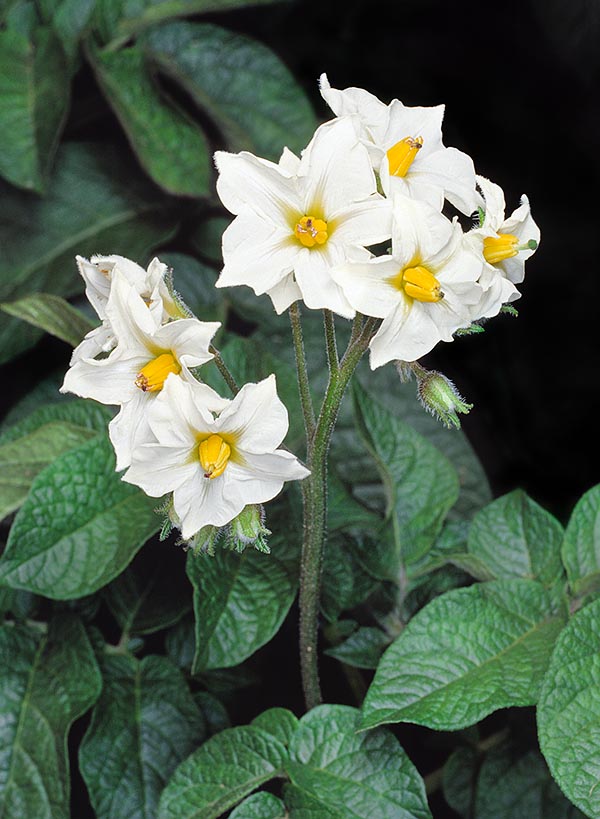
The Potato (Solanum tuberosum) may even exceed 1 m of height © Giuseppe Mazza
Solanaceae.
The name Solanum comes from the Latin “solamen” = consolation, comfort, due to the medicinal and sedative properties of some species of this genus (Solanum in Latin was the name of the Solanum nigrum); the name of the species, tuberosum, comes from the Latin “tuberum” = bump, excrescence, but also truffle, in reference to the production of tubers.
The English name, potato, as well as the Italian one, “patata”, comes from a confusion between the tuber of the Solanum tuberosum and the one of the Ipomoea batatas, the sweet potato, a convolvulacea of Central-American origin which the Caribbean Taíno populations called “batata”. The confusion has also been facilitated by the fact that the name in Quechuan is papa.
The wild progenitors of the potato are native to South America, in particular the highlands of the Andes, from Colombia to Chile. In this area are present more than two hundred wild species. The greatest diversity is found in the Titicaca Lake region.
Nowadays, the potato is amply cultivated in all the continents, and represents the fourth most cultivated plant of the planet, after only the wheat, the rice and the maize.
Morphology
During the first stages of the development, the stems have an erect habit but, once ripe, in correspondence with the production of the tubers, they get a prostrate habit and often turn yellow. The plant is hairy, with ramified and succulent stems and is characterized by underground stolons forming tubers. The leaves are pinnate-compound, with 7-9 alternate leaflets. The inflorescences are terminal, with five petals flowers, which may be white, pink, blue or purple, with yellow stamina. The flowers are carried by a 2-3 cm peduncle. After blooming, some varieties produce a spherical fruit, yellowish or purplish, of 2-3 cm of diameter, toxic, containing numerous seeds (up to 300). Other varieties have imperfect flowers, do not produce fruits and reproduce therefore only by vegetative propagation. The tuber, of much variable colour depending on the variety, forms as a swelling of the terminal part of the long underground stolons thanks to the accumulation of starch, and is covered by a thin epidermis. The potatoes are pollinated by insects, especially by hymenopterans of the genus Bombus. The pollination is usually crossed, but also a self-pollination may occur. The potato reproduces also in vegetative way, planting in the ground tubers of parts of them. It should be remembered that erroneously the tubers, or their parts, which are interred for reproducing the plants are called “seed potatoes” and it is used the term of “to seed” the potatoes.
Nutritional value
The potato contains mainly carbohydrates (19 g /100 g of boiled potato), but also proteins (2 g), and, moreover, is rich of trace elements and of various vitamins, especially of vitamin C, and this renders the tuber an extremely important anti-scurvy aliment.
History
The first inhabitants of the Americas, during their movement southward, met various species of solanaceous producing comestible tubers and quite probably did use them.
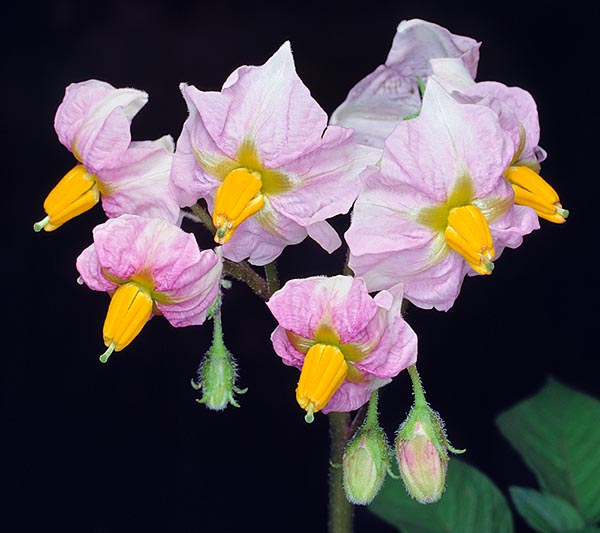
The five-petals flowers can be white, pink, blue or purple, with yellow stamina © Giuseppe Mazza
In the same regions, at lower altitudes, the old Americans started the domestication of the maize, whilst at high altitudes, besides the potato, they did grow plants, precious for the high proteinic content, such as the Quinoa (Chenopodium quinoa, a kindred to the spinach), and the Kiwicha (Amaranthus caudatus).
The potato in particular, which with some of its varieties grows up to altitudes well over the 4000 metres, allowed the populating of the Andean highlands and has represented for many centuries the base of the alimentation for these peoples. It is likely that Solanum tuberosum comes from the domestication of the wild species Solanum stenotomum hybridized with Solanum sparsipilum or with some other species. This hybridization should have originated Solanum tuberosum andigena, amply cultivated in the northern Andean regions and later on, through other hybridisations, Solanum tuberosum tuberosum mainly diffused in Chile. The American peoples did cultivate many varieties of potatoes, suitable to the different altitudes and uses. Still now, in South America they grow hundreds of different varieties, belonging to numerous species and subspecies. In the only Peruvian department of Huancavelica, they grow at least 600 varieties of potato, belonging to various species besides Solanum tuberosum, such as Solanum ajanhuiri, Solanum juzepczukii, Solanum goniocalyx (much utilized with the name of “papa amarilla”) and hybrids of these species with Solanum tuberosum. These different species are characterized by different numbers of chromosomes, multiple of a haploid value n=12 (there are forms at n=24, n=36, n=48 and n=60, probably caused by phenomena of polyplodzation and hybridization). Many scholars think the origin form is the one at n=24 (maybe Solanum brevicaule).
The first encounter of the Europeans with the potato did probably happen in 1536, when the Gonzalo Jimenez de Quesada expedition, once passed the Rio Magdalena valley, in Colombia, reached the highlands. In the village of Sorocotà, relates Juan de Castellanos, the natives ran away upon the arrival of the Spaniards and these ones, once entered the huts, found maize, beans and “truffles”. The Spaniard accurately describes the “truffles” as well as the plant producing them, which is rightly the potato, and commends its flavour. Two years later, Cieza de Leòn meets the potato again and describes it accurately in an opus dated 1550, reporting the local name of “papa” and citing its alimentary importance. The description done by Cieza de Lèon is usually considered as the first discovery, thanks to the fact that Castellanos’ relation, even if antecedent was printed only in 1886.
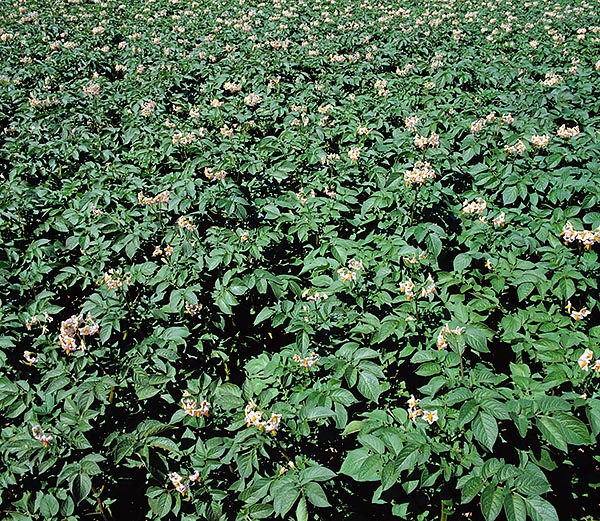
Native to America is now tilled in all world with countless varieties © Giuseppe Mazza
The potato originally imported in Europe was probably the andigenum, characterized by very irregularly shaped tubers and much pronounced eyes. Only later did come the species now cultivated in Europe, which is the Solanum tuberosum. After many scholars this species is native to Chile, in particular to the southern regions (Chiloè Island and adjacent regions), where are present wild Solanum tuberosum.
Other authors question this hypothesis for historical reasons, as at the times when the potato reached Europe the links between southern Chile and Europe were scarce and very slow, as well as for the presence of quite similar forms cultivated at the time in much northernmost regions of South America, like in the region of Bogotá.
The first potatoes were cultivated in Europe as ornamental plants. The cultivation of the potato for food purposes began probably in Spain after 1564, as a matter of fact, records of that year do not talk of the plant as cultivated as foodstuff, but surely before 1573, when the potato was already included in the diets of one of the hospitals of Seville. Perhaps the first Spanish cultivations took place in the countries along the coast of the Bay of Biscay, made by the families of Basque sailors who had carried the tubers from America.
After Spain, the potato probably reached Great Britain, where it seems to have arrived in 1588, they say by the navigator, privateer and favourite of Queen Elizabeth, Sir Walter Raleigh, one of the explorers of the Americas and sponsor of their colonization. It seems that Raleigh himself has made it cultivated in his lands in Ireland, thus originating the enormous diffusion in that country. Raleigh’s fame is also due to the introduction of the use of the tobacco in Great Britain. The first botanical description of the potato dates of 1596, by the British John Gerard who calls it Virginia potato, due to a misunderstanding about the provenience of the specimens he observed (probably, Virginia had been a stop in the journey of the specimens towards Europe).
Potatoes and truffles
The confusion between potatoes and truffles originates since the first contacts the Europeans had with the potato: in fact Castellanos, the first Spaniard to see it, calls it truffle (trufa). This misunderstanding perpetuated for what concerns the name as well as for its properties. In Italy, they adopted the name of “tartuffolo” (in Liguria, Lombardy, Piedmont and Valle d’Aosta, the local names Truffa, Tartifola and similar are still now used), which then became also “cartuffolo” (whence, the German Kartoffel). This terminological confusion coincided with the attribution to the potato of the aphrodisiac powers of which the truffle was considered endowed, also in the countries which had adopted names not linked to the truffle.
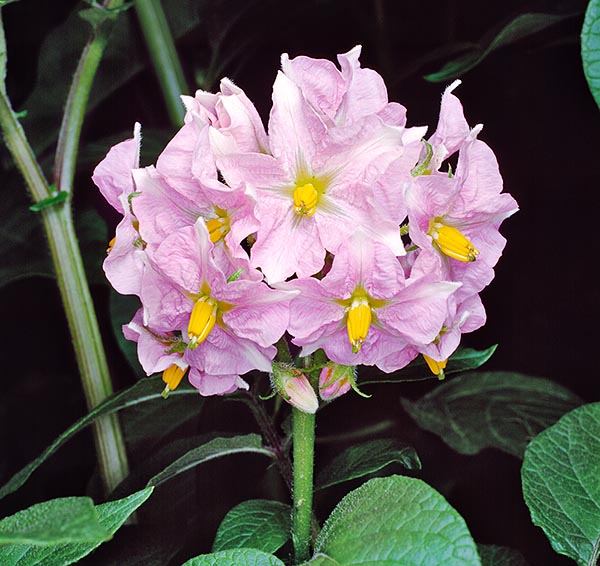
At King Louis XVI buttonhole, was publicized by feasts and unwatched nobles cultivations © G. Mazza
Shakespeare, Merry Wives of Windsor, act 5, scene 5 (Falstaff thinks to be obliged to part between two women, Mrs. Ford and Mrs. Page and invokes a rain of aphrodisiac potatoes).
“Let the sky rain potatoes” (often translated in Italian with truffles, as Italians consider these last as more aphrodisiac than potatoes: also Boito, in the Verdi’s Falstaff libretto, makes a rain of Truffles).
Almost all the old description of the alimentary properties of the potato consider it as favourable for the procreation and cause of flatulency (it is worthy to quote the somewhat derogatory voice of the Encyclopédie: “a quite healthy food to the men who just ask to be fed. The potato is condemned, and rightly, because generates flatulence, but what importance do have the flatuses if the organs of the countrymen and of the workers are vigorous?”
By the end of the ‘500 the potato was already known in most of Europe, but especially as ornamental plant. Outside Spain and Great Britain, strong were the resistances to use it, unless as food for the animals. The potato was considered as cause of leprosy and scrofula, seen the lumpy and full of “eyes) shape, similar to the leprous lesions (the medical doctrine of “signs” declared that similar shapes treated or caused similar diseases, for instance the Hepatica nobilis, with its liver-coloured leaves should have cured the liver ailments). Moreover, the potato was not reported in the Bible and therefore was refused by religious fundamentalists, for instance in Scotland or in Russia. To this we have to add the refusal for anything that is new or different but especially the fact that the potato is similar to highly toxic plants, such as the Solanum nigrum, the deadly nightshade, etc., and that consequently it is itself toxic in its green parts.
Only in Prussia, King Frederick II had obliged the countrymen to cultivate and to eat it; under threat of heavy fines (since 1756 by royal decree each family unit had to consume at least 2 kg of potatoes per week, without distinction between the people and the nobles). The King enacted also rules for the use making clear that the potatoes had to be consumed cooked. It is emblematic what happened in France, where, still during the second half of the ‘700, the food was refused or utilized only for animals (the French parliament in 1748 had forbidden the cultivation of the potato, because cause of leprosy). The apothecary and agronomist Antoine Agustin Parmentier had been prisoner of the Prussians at the times of the Seven Years’ War (1756-1763) and during his imprisonment had learnt to appreciate the potatoes as food, realizing also their properties as anti-scurvy. When back in France he strived for the diffusion of the use of the potato, being able to induce the Paris Faculty of Medicine to declare edible the potato and, moreover, to interest to the problem the King Louis XVI. Facing the resistances of the countrymen, Parmentier came up with a clever psychological trick: he convinced the King to cultivate potatoes in the royal properties fields, fenced and watched by the soldiers, thus giving the impression of an exclusive and precious cultivation. The soldiers however had the order to loosen the monitoring during the night and therefore the good countrymen hurried up in stealing the valuable potatoes for cultivating them in their orchards and eating them feeling as many Kings! Then, when a serious famine broke out, in 1785, the potatoes saved the north of France from the hunger.
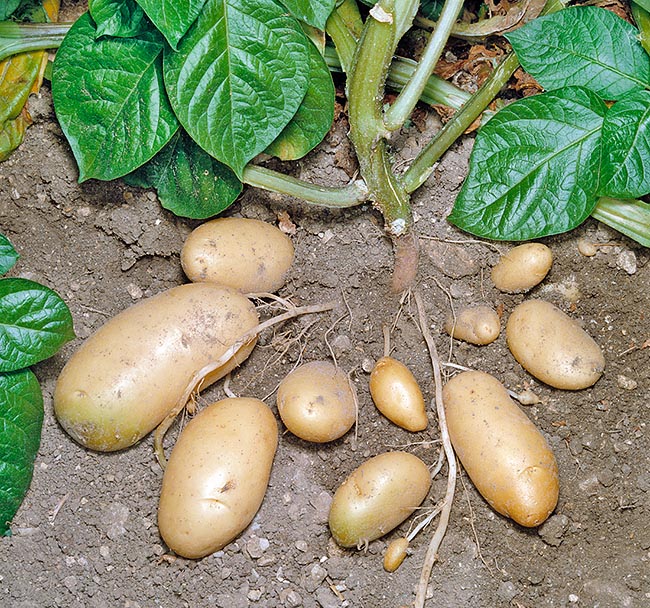
The tubers are rich in carbohydrates, also proteins, trace elements, vitamins, mainly C © Giuseppe Mazza
Parmentier is also known for having introduced the compulsory smallpox vaccination in the Napoleonic army (1805) and his name is linked to many culinary recipes based on potatoes.
At the end of ‘700, the cultivation of the potato was had become widespread in Europe and in some countries the tuber had become an essential part of the alimentation of the lower classes, thanks to the high productivity and to the high content of nutrients.
The potato in Ireland
In Ireland, the cultivation of the potato began, as we have already said, at the end of the ‘500 and, starting from ‘700, it was diffused in great part of the Island.
Between ‘700 and ‘800 the great landowners, usually British or Irish living in Great Britain dedicated their lands to the cultivation of the flax, of the cereals or to the breeding. The families of the countrymen working those lands had available for their own use very small parcels planted with potatoes, from which they did fully depend for their survival. In the poorest regions of the country, the potato was on the contrary the only product.
Practically therefore the Irish population lived of potatoes accompanied by little milk and extremely rare meat (it is estimated that the average per capita consumption was of 5-6 kg of potatoes per day). The first indications of the precariousness of this situation showed up in 1816 and then in 1820, when particularly unfavourable years seriously diminished the production of potatoes and caused the death of thousands of countrymen.
In 1845 appeared an infestation of Potato blight (Phytophthora infestans, an oomycete), that destroyed a good part the harvest of potatoes.
The following year the attack manifested again. The result of the almost complete loss of the harvest of potatoes during two successive years was catastrophic: it is estimated that at least one million of persons died for starvation and a greater number was obliged to emigrate, thus increasing the Irish communities especially in North America and in Australia (according to 1841 census the Irish population was of 8.175.124 persons, but at least one million of homeless people was not surveyed; therefore the total did probably exceed the 9 million). In 1851 the population had dropped to about 6 million! Despite the dramatic situation the landowners continued the export in England of wheat and livestock even if no rescue at all did come from Great Britain.
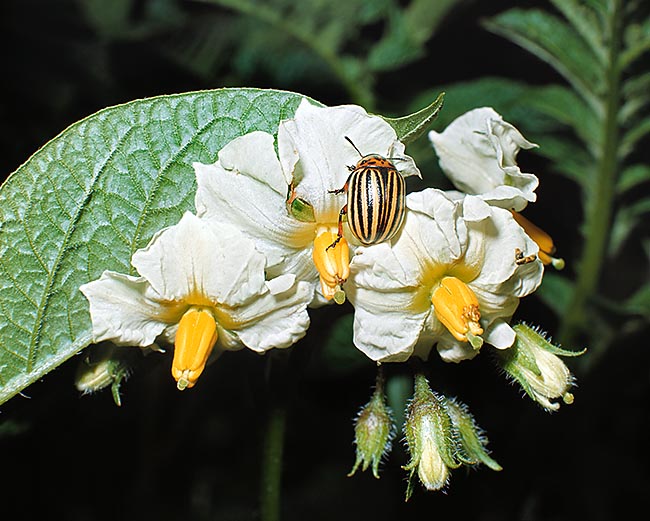
Is attacked by various insects, especially the Colorado beetle that can defoliate it all © Giuseppe Mazza
The potato in Italy
It appears that the introduction of the potato in Italy has taken place thanks to the Discalced Carmelites who carried it to Liguria from Spain. The cultivation then extended in Piedmont, especially in the Waldensian communities. The diffusion of the use of the potato in Italy was stimulated by public interventions, mediated also by the ecclesiastical authorities; dated 1793 is a pamphlet entitles “About the fruits of the earth, that is potatoes” sent to all rural parish priests of the Most Serene Republic if Genoa, where are praised the nutritional and organoleptic properties of the tuber and suggestions are given about its cooking and its culinary utilization.
The potato in America
After its trip in Europe, the potato did conquer North America. The potatoes reached North America in 1621 when the Governor of Bermuda, Nathaniel Butler, sent to the Governor of Virginia some cases containing potatoes and other vegetables. The first stable cultivation took place around the 1719 in New England, done by Scottish or Irish immigrants. Since then the potato had an enormous development and nowadays Idaho is the main producer. It is to be remembered that during the Klondike Gold Rush (1897-1898) the potatoes were practically exchanged with the gold at equal weight. They had a lot of gold, but this was not edible!
Toxic properties
Like all solanaceous, the potato contains toxic alkalods, above all the solanine and a similar molecule, the chaconine. These substances are present in all the parts of the plant, but especially in the green parts and in the skin of the tuber. The solanine is thermostable and therefore is not destroyed by the cooking. The most common varieties of potato do contain 10-20 mg of alkaloids per kg, whilst the green tuber reaches the 250-280 mg/kg and the green skin the 1500/2200 mg/kg.
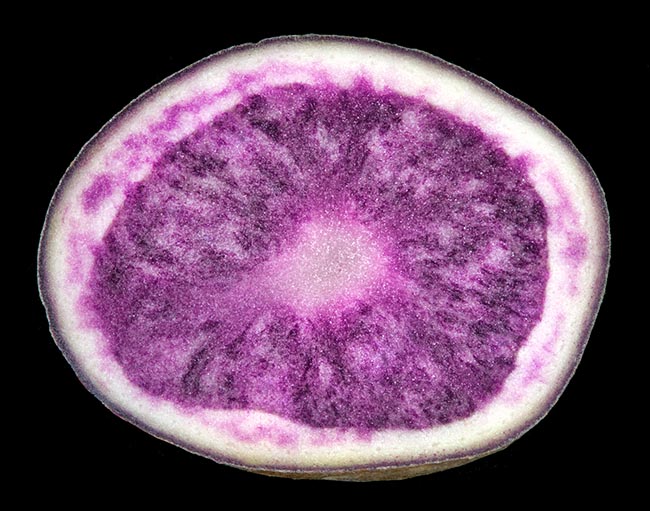
The 'Bleue d'Artois'. Odd variety, violet when cut turning blue while cooking © Giuseppe Mazza
Potato diseases
Numerous are the pathogens which may affect the potatoes, amongst which various viruses, bacteria like the Pectobacterium carotovorum, some cryptogams like the infamous Late blight (Phytophtora infestans), responsible of the catastrophic Irish famine of the ‘800, nematodes among which the known Potato root eelworm (Heterodera rostochiensis), or insects like the Ten-lined potato beetle (Leptinotarsa decemlineata), the treacherous European mole cricket (Gryllotalpa gryllotalpa) or the well known Cockchafer (Melolontha melolontha). Nowadays, against these pathogens are available numerous methods of chemical or biological struggle.
Traditional uses
The populations of the Andean highlands had developed a method for drying and conserving the potatoes which is still now extremely diffused. The product obtained, indicated under the name of quechua chuño, is commercialized in all the markets of Peru and of the nearby countries and enters many traditional recipes. The method consists essentially in freezing the potatoes, usually of small size, leaving them on night at the open air: the product in the process of defrosting is pressed with bare feet to eliminate the water. Usually the operation is repeated for three cycles of frosting and pressing and finally with the exposition to the sun the residual water is eliminated. The chuño is conserved without any problem for many years. There are products varying in appearance and colour, indicated with various names.
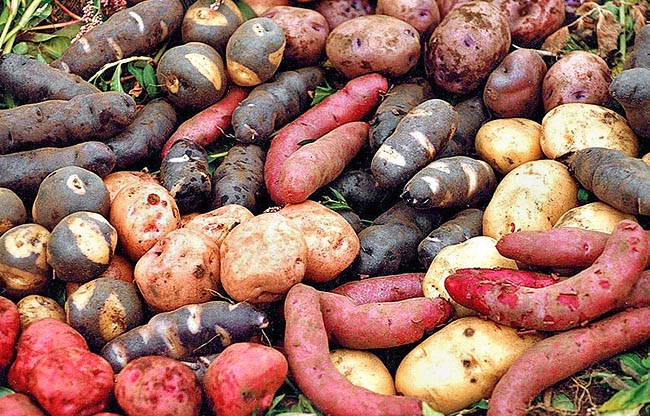
A market in Ecuador with many local varieties of potatoes © Pablo Castillo Cuevas
Sacred aspects and ceremonies
To the potato and its cultivation, seen the extraordinary importance for the alimentation of the Andean populations, were associated numerous propitiatory rituals (some of which are still practiced). The shedding of blood over the seed potatoes or on the soil was a diffused practice, with many variants: blood coming from the human sacrifice or of the animals was poured before or after the planting of the seed potatoes; during the celebrations in the sowing period more or less ritualized fights took place, and these led to the shedding of blood where the potatoes were dipped. The shedding of blood symbolized the transfer, to the potato or to the ground, of the strength of which the blood was symbol. Moreover, such important event like the sowing could not by sure take place without an offering to the “Pachamama”, the Mother Earth (or, better, Mother World). In the first excavation done for the sowing were placed some leaves of the sacred Coca (the offering of the coca to the Pachamama is still now effected in many occasions; many drivers do not start a voyage without having previously done the offering and the Titicaca boatman throws four leaves in the water as soon as sailed).
For the cultivation of the potato, the soil was tilled by the men, who utilized a special spade, the taclla, still now used in some locations, identical to the Incan one. Then the women overturned the clods (the distribution of the work between the sexes did vary depending on the regions). The so prepared field was left resting for the whole winter and sown with the tubers in spring.
The work of mindless destruction acted by the Spanish conquerors has deprived us of most of the artistic evidence of the South American peoples. A trace of the potato has remained in the wonderful pre-Incan ceramics Nazca or Moche, where the tuber, often anthropomorphized, is the protagonist. Also in Ireland, to the cultivation of the potato were associated ritual activities, linked, for example, to the date of sowing, which in many regions had absolutely to start on Good Friday, independently from the period it did fall, or salt was dispersed on the potatoes before sowing. In the furrow was driven a pile of cypress wood and on the Ascension Day holy water was sprinkled on the plants. The great famine, in some regions of Ireland, was associated to the Fairies: it was thought that on St. John’s day the Fairies of every region did fight in battle and the region of the defeated Fairies should have suffered from a calamity. In the specific, the Ulster Fairies were defeated and hence should have originated the famine (perhaps, nowadays, the fungicides help the Fairies!).
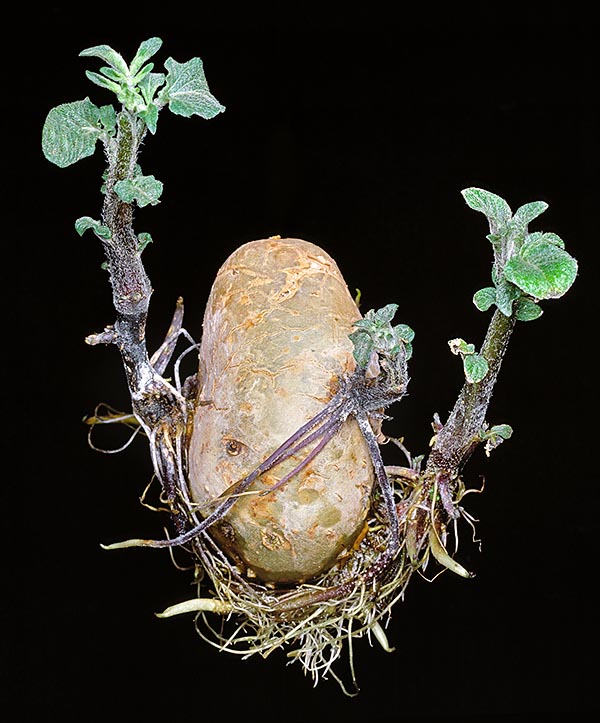
Budding tubers, skin and green parts are toxic © Giuseppe Mazza
The medicinal uses or superstitions of the potato are countless; some of them date back to the old South American peoples. Only a few examples are here mentioned. Slices of raw potato are applied on bruises or on fractures to accelerate healing. Juice of raw potato is utilized for treating the chilblains, the burnings, the sunburns and acne. Against the pain, rub the aching part with the water where some potatoes have been boiled. These recipes were already used in the Andean peoples and an important opus of medicine of the ‘800 (Domenico Bruschi, Istituzioni di Materia Medica 1834), relates about analogous recipes, with the same indications, for the potatoes as well as for the purified potato starch. To carry a potato in the pocket for curing the toothache or the rheumatic ailments. For the sore throat, tie around the neck a sock containing slices of cooked potato. He who wants to win the game must carry in his pocket a potato or a chicken paw. The potato was used in curing the warts: the healer, with a nail, made some holes in the potato, of the same number as that of the warts. The patient had then to throw the potato in a place where he had never to go again, at risk of seeing reappear the warts. They say that the old Peruvians did utilize the potato also as means for measuring the time, utilizing as unit the time necessary for cooking a potato. But the size of the potato is not specified.
Curiosities
The potato can be used for the production of electric energy: inserting in fact an electrode made of copper and one of zinc in a potato we obtain an electric battery. After some Israel researchers, the system can be improved by using a potato boiled for eight minutes and the potato battery can be used to illuminate a room with LED lamps or even to power a mobile phone or similar devices. After these Israeli researchers, it might be possible to think to introduce this technology in developing countries or in isolated locations where an electrical network is not available. The potato may boast to be the first vegetable grown in the space. In 1995, in fact, the NASA has started some experiments aimed to produce potatoes in the spacecrafts, with the purpose of obtaining an alimentary source to be used during the interplanetary travels or in possible future space settlements.
Synonyms
Solanum aracatscha Bess.; Solanum sinense Blanco; Solanum esculentum Neck.; Lycopersicon tuberosum (L.).
→ To appreciate the biodiversity within the SOLANACEAE family please click here.
